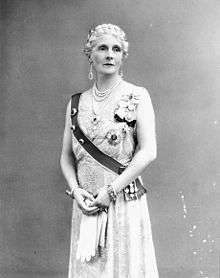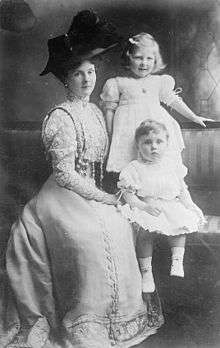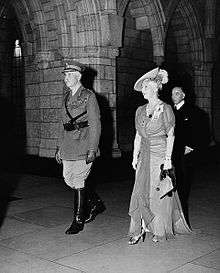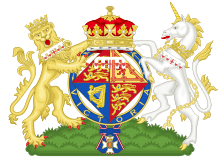Princess Alice, Countess of Athlone
| Princess Alice | |||||
|---|---|---|---|---|---|
| Countess of Athlone | |||||
 | |||||
| Born |
25 February 1883 Windsor Castle, Berkshire | ||||
| Died |
3 January 1981 (aged 97) Kensington Palace, London | ||||
| Burial | Frogmore, Windsor, Berkshire | ||||
| Spouse | Alexander Cambridge, 1st Earl of Athlone | ||||
| Issue |
Lady May Abel Smith Rupert Cambridge, Viscount Trematon Prince Maurice of Teck (died in infancy) | ||||
| |||||
| House |
Windsor (since 1917) Saxe-Coburg and Gotha (until 1917) | ||||
| Father | Prince Leopold, Duke of Albany | ||||
| Mother | Princess Helena of Waldeck and Pyrmont | ||||
Princess Alice, Countess of Athlone, GCVO, GBE, GCStJ, VA (Alice Mary Victoria Augusta Pauline; née Princess Alice of Albany; 25 February 1883 – 3 January 1981), was a member of the British Royal Family. She is the longest-lived Princess of the Blood Royal of the British Royal Family and the last surviving grandchild of Queen Victoria. She also held the titles of Princess of Saxe-Coburg and Gotha and Duchess in Saxony from birth, as well as a Princess of Teck by marriage, until 1917 when the British Royal Family ceased usage of German titles. She was godmother to Queen Beatrix of the Netherlands, who is the granddaughter of her first cousin on her mother's side, Queen Wilhelmina of the Netherlands.
Early life
Princess Alice was born 25 February 1883 at Windsor Castle. Her father was Prince Leopold, Duke of Albany, the youngest son of Queen Victoria and Prince Albert of Saxe-Coburg and Gotha. Her mother was Princess Helena of Waldeck and Pyrmont. She had one brother, Prince Charles Edward, Duke of Albany (1884–1954) and later reigning Duke of Saxe-Coburg and Gotha (1900–1918). As the granddaughter of the Sovereign through the male line, she was a Princess of the United Kingdom and a Royal Highness. As the daughter of the Duke of Albany, she was, therefore, styled Her Royal Highness Princess Alice of Albany.
She was baptised in the Private Chapel of Windsor Castle on 26 March 1883, and named Alice for her late paternal aunt. Her godparents were: Queen Victoria (her paternal grandmother); the German Empress (for whom Alice's paternal aunt Princess Beatrice stood proxy); William III, King of the Netherlands (her maternal uncle by marriage, for whom the Dutch Ambassador Count van Bylandt stood proxy); Louis IV, Grand Duke of Hesse (her namesake's widower and her paternal uncle by marriage, whose brother-in-law the Duke of Edinburgh represented him); the Princess of Waldeck-Pyrmont (her maternal grandmother); the Prince of Wales (her paternal uncle); the German Crown Princess (her paternal aunt, whose sister-in-law the Princess of Wales represented her); Prince Wilhelm of Württemberg (her maternal uncle by marriage, for whom his cousin the Duke of Teck stood proxy); the Hereditary Princess of Bentheim and Steinfurt (her maternal aunt, for whom her paternal aunt Princess Christian stood proxy); and the Duchess of Cambridge (an aunt of the Queen, whose daughter the Duchess of Teck represented her).[1]
Marriage and issue

On 10 February 1904, at St George's Chapel, Windsor, Princess Alice of Albany married her second cousin once-removed, Prince Alexander of Teck, the brother of Princess Mary, the Princess of Wales (later Queen Mary, consort of George V).[2] After their marriage, Princess Alice was styled HRH Princess Alexander of Teck.
Prince and Princess Alexander of Teck had three children:
| Name | Birth | Death | Notes |
|---|---|---|---|
| Lady May Cambridge | 23 January 1906 | 29 May 1994 | Married 1931 to Henry Abel Smith; had issue |
| Rupert Cambridge, Viscount Trematon | 24 August 1907 | 15 April 1928 | Died in a car crash |
| Prince Maurice of Teck | 29 March 1910 | 14 September 1910 | Died in infancy |
Princess Alice was one of the carriers of the gene for haemophilia which originated with Queen Victoria. Princess Alice inherited the gene from her father who himself was a sufferer.
Change of titles
When the British Royal Family abandoned all Germanic titles in 1917, Prince Alexander of Teck adopted the surname Cambridge, became (briefly) Sir Alexander Cambridge, then the Earl of Athlone, relinquishing the title "Prince of Teck" in the Kingdom of Württemberg and the style Serene Highness. As such, the two surviving children lost their Württemberg princely titles. Princess Alice relinquished her titles of Princess of Saxe-Coburg and Gotha and Duchess of Saxony, whilst her brother Charles Edward, Duke of Saxe-Coburg and Gotha, who held a commission in the German Army, was stripped of his British titles. Alice remained, however, a Princess of Great Britain and Ireland and a Royal Highness in her own right, as granddaughter of Queen Victoria in the male line.
Residences
Following the Earl's retirement from military service after World War I, the Athlones used for their London residence the grace and favour apartments of the late Duchess of Albany (1861-1922), Princess Alice's mother, in the Clock House at Kensington Palace; in 1923, they also acquired a country house, Brantridge Park in West Sussex.[3]
South Africa
The Earl was appointed Governor-General of the Union of South Africa and served from 1924 to 1931: Princess Alice accompanied him and was the Vicereine during that period. Lord Athlone and Princess Alice had a coastal beach house constructed at Muizenberg, which still stands today and is one of South Africa's national monuments. The Cape Town suburb of Athlone was named in honour of the Governor-General and, apart from the beach house and the preserved Class GL Garratt steam locomotive Princess Alice in the Outeniqua Transport Museum, are the only physical reminders of the Athlones' residence at the Cape. She became a lifelong friend of the South African politician Bernard Friedman and the South African writer Thelma Gutsche.
World War II and Canada

On the sudden death of the vastly popular John Buchan in 1940 Canada found itself without a Governor General in time of war. Despite the longstanding intention of Canadian governments to indigenise the office and appoint Canadian nationals as governors general — Australia had already done so with the appointment of Sir Isaac Isaacs as its governor general in 1931 — wartime seemed an unpropitious time for constitutional tinkering; the Royal Family had garnered vast public support during the Royal Tour of 1939; as Queen Mary's brother and a former governor general of another of His Majesty's Dominions (as they were then styled), Lord Athlone seemed a satisfactory candidate notwithstanding considerations of talent, and Mackenzie King advised the King to appoint him.
Princess Alice accompanied her husband to Canada where he served as Governor General from 1940 to 1946. Upon taking up his post, The Earl immediately made himself active in the support of the war effort, travelling across the country and focusing much of his attention on the troops, either those training at military facilities or those injured and in hospital. Viewing his position as governor general as a link between Canadians and their monarch, Athlone also communicated in speeches that the King stood with them in their fight against Adolf Hitler and the Nazi regime.[4]
As vicereine of Canada, Princess Alice also supported the war effort by serving as Honorary Commandant of the Women's Royal Canadian Naval Service, Honorary Air Commandant of the Royal Canadian Air Force Women's Division and president of the nursing division of the St. John Ambulance Brigade.[5]
In 1944, the Princess Alice Barracks Cabin at Britannia Bay provided a summer retreat for Royal Canadian Air Force Women's Division personnel based in Ottawa. The cabin was located near the Britannia Boating Club's facilities for tennis, dancing and boating. Rented from the King's Daughter's Guild of Ottawa, the cabin featured 60 beds, a separate cookhouse and dining pavilion. The cabin, which had served previously as a Fresh Air Cottage for mothers and undernourished children, was rented from the King's Daughter's Guild of Ottawa.[6]
The war was brought close to home for the Athlones also because many of those belonging to displaced European royal families sought refuge in Canada and resided at or near the royal and viceroyal residence, Rideau Hall. Among the royal guests were Crown Prince Olav and Crown Princess Märtha of Norway; Grand Duchess Charlotte and Prince Felix of Luxembourg; King Peter of Yugoslavia; King George of Greece; Empress Zita of Bourbon-Parma (Austria) and her daughters; as well as Queen Wilhelmina and her daughter, Princess Juliana.[7] Further, in December 1941, British prime minister Winston Churchill arrived at Rideau Hall, where he presided over British Cabinet meetings via telephone from his bed.[8]
The viceregal couple also played host at Quebec City to prime minister Mackenzie King, as well as Churchill and United States president Franklin D. Roosevelt, who all gathered to take part in what would become known as the Quebec Conferences, with the first taking place between 17 and 24 August 1943 at the viceregal residence in La Citadelle, and the second occurring from 12 to 16 September 1944 at the Château Frontenac. Photos of the Earl with Roosevelt, Churchill and Mackenzie King on the ramparts of the Citadel during the Quebec Conference were widely published at the time.

It was at these meetings that the four men discussed the Allied strategies that would eventually lead to victory over Nazi Germany and Japan. When Germany fell on 8 May 1945 and Japan on 15 August of the same year, Athlone led the national celebrations held on Parliament Hill and elsewhere. He thereafter spoke in speeches about Canada's future being marked not by war but by a strong role in reconstruction and reconciliation.[4]
During their time in Canada, the Athlones also supported various charitable and social events, and mounted a number of tobogganing parties and skating lessons on the grounds of Rideau Hall, as well as skiing in Gatineau Park. Before the couple departed from Canada at the end of Athlone's time as the King's representative, he left as a legacy the Athlone-Vanier Engineering Fellowship, awarded by the Engineering Institute of Canada.[4]
Post-World War II
At the end of World War II, the American Military Government in Bavaria, under the command of General George S. Patton, arrested and imprisoned Alice's brother, Charles Edward, Duke of Saxe-Coburg and Gotha, (who served as a member of the Reichstag from 1937 to 1945), because of his Nazi sympathies. Alice, learning of her brother's incarceration, came to Germany with her husband to plead with his American captors for his release. They would not yield, and in 1946, he was sentenced by a de-nazification court, heavily fined and almost bankrupted.[9][10]
Royal duties
In her lifetime, Princess Alice carried out many royal duties. Apart from her normal duties as Vicereine of South Africa and then Canada, she attended the Coronations of five monarchs: Edward VII, George V, George VI, Elizabeth II and Queen Juliana. She was also the Colonel-in-Chief of two British Army units and one Rhodesian Army unit. During the Second World War, she was Honorary Air Commandant of the Royal Canadian Air Force Women's Division. In 1950, she became the first Chancellor of the University of the West Indies (then the University College of the West Indies). From the 1930s-60s she was Chair of the Council (governing body) of Royal Holloway College, University of London.[11] With her husband, daughter and son-in-law, Princess Alice represented the King at the 1937 wedding of Juliana of the Netherlands to Prince Bernhard of Lippe-Biesterfeld.[12]
The Princess and her husband visited Bahrain and Saudi Arabia in the winter of 1938.[13] She was the first British royal to visit the country and the only British royal to meet King Abdulaziz.[14][15] Their nephew Lord Frederick Cambridge accompanied them in the visits.[16] In Saudi Arabia Princess Alice visited Riyadh, Hofuf and Dammam, and met Noura bint Abdul Rahman, sister of the King and other members of the Saudi royal family.[17]
In 1966, Princess Alice published her memoirs, For My Grandchildren, narrating her life and royal duties and visits.[13][18]
Death
The Earl of Athlone died in 1957 at Kensington Palace in London.[16] Princess Alice lived on there until 1981, when she died at age 97 years and 313 days. At her death, she was the longest-lived British Princess of the Blood Royal and the last surviving grandchild of Queen Victoria. The funeral of Princess Alice took place in St George's Chapel at Windsor Castle, attended by all members of the Royal Family. She is buried alongside her husband and son in the Royal Burial Ground, Frogmore, directly behind the mausoleum of Queen Victoria and Prince Albert, in Windsor Great Park. Her daughter and son-in-law are also buried close by.
She lived through six reigns: those of Queen Victoria (grandmother), Edward VII (uncle), George V (cousin and brother-in-law), Edward VIII (first cousin once removed and nephew), George VI (first cousin once removed and nephew) and Elizabeth II (first cousin twice removed and grand-niece).
Titles, styles, honours and arms

Titles and styles
- 25 February 1883 – 10 February 1904: Her Royal Highness Princess Alice of Albany
- 10 February 1904 – 14 July 1917: Her Royal Highness Princess Alexander of Teck
- 14 July 1917 – 17 July 1917: Her Royal Highness Princess Alice, Lady Cambridge
- 17 July 1917 – 3 January 1981: Her Royal Highness Princess Alice, Countess of Athlone
Honours
- GCVO: Dame Grand Cross of the Royal Victorian Order
- GBE: Dame Grand Cross of the Order of the British Empire
- GStJ: Dame Grand Cross of the Venerable Order of Saint John of Jerusalem
- VA: Lady of the Royal Order of Victoria and Albert
- Royal Family Order of King Edward VII
- Royal Family Order of King George V
- Royal Family Order of King George VI
- Royal Family Order of Queen Elizabeth II
Arms
As a granddaughter of Queen Victoria in the male line, Princess Alice was entitled to use the Royal Arms, with a 5-point label as a difference, the central point bearing a cross gules, the others hearts gules.
Ancestry
References
- ↑ Yvonne's Royalty Home Page — Royal Christenings
- ↑ Stegner, Wallace (January–February 1969). "Discovery! The Story of Aramco Then". Saudi Aramco World. 7.
- ↑ Aronson, Theo (1981). Princess Alice, Countess of Athlone. London: Cassell. p. 123. ISBN 0304307572. Retrieved 2 June 2016.
- 1 2 3 Office of the Governor General of Canada. "Governor General > Former Governors General > Major General The Earl of Athlone". Queen's Printer for Canada. Archived from the original on 11 February 2009. Retrieved 24 March 2009.
- ↑ "The Earl of Athlone," Former Governors General, The Governor General of Canada, accessed 22 April 2011.
- ↑ the Princess Alice Barracks Cabin at Britannia Bay Ottawa Citizen Jul 10, 1944
- ↑ Hubbard, R.H. (1977). Rideau Hall. Montreal and London: McGill-Queen's University Press. p. 201. ISBN 978-0-7735-0310-6.
- ↑ Hubbard 1977, p. 202
- ↑ Hitler's Favourite Royal (Channel 4 documentary) Dec 2007
- ↑ The Nazi relative that the Royals disowned - Daily Mail - Dec 2007
- ↑ 1937 Royal visit of Queen Mary to Royal Holloway College, Egham, 1937
- ↑ "Crown Princess Juliana of the Netherlands & Prince Bernhard of Lippe-Biesterfeld -1937". Royal Forums.
- 1 2 "Sotheby's To Sell An Historic Album Photographs Recording the First British Royal Visit to Saudi Arabia and Bahrain". Art Daily. Retrieved 19 July 2013.
- ↑ "Journey of a Lifetime Exhibition". Riyadh Events. Retrieved 19 July 2013.
- ↑ "Exhibition recalls historic royal visit to Saudi". Cronwall. 3 July 2010. Retrieved 19 July 2013.
- 1 2 Morris, Loveday (30 July 2011). "Alice in Arabia: the first British royal to visit Saudi Arabia". The National. Retrieved 21 July 2013.
- ↑ "The journey of a lifetime". Geographical. July 2011. Retrieved 21 July 2013.
- ↑ Princess Alice, Countess of Athlone (1966). For My Grandchildren:. London: Evans Bros. Retrieved 8 January 2016.
External links
| Wikimedia Commons has media related to Princess Alice, Countess of Athlone. |
- regiments.org listing of honours and military titles
- A YouTube video of HRH Princess Alice speaking informally about Queen Victoria, her paternal grandmother; circa 1976
| Princess Alice, Countess of Athlone Cadet branch of the House of Wettin Born: 25 February 1883 Died: 3 January 1981 | ||
| Honorary titles | ||
|---|---|---|
| Preceded by The Baroness Tweedsmuir |
Viceregal Consort of Canada 1940–1946 |
Succeeded by The Countess Alexander of Tunis |
.svg.png)